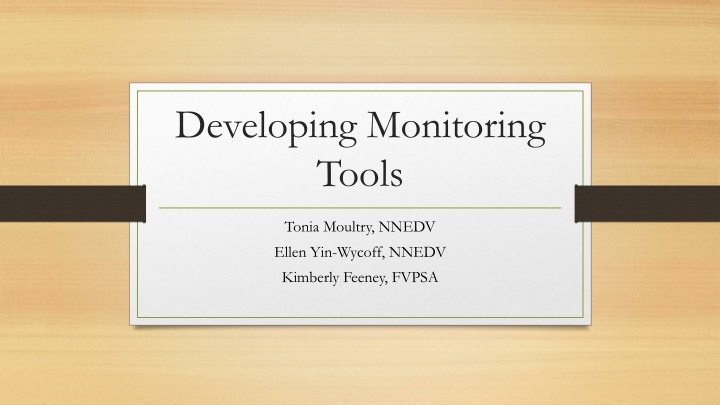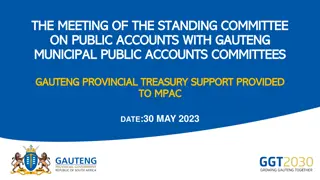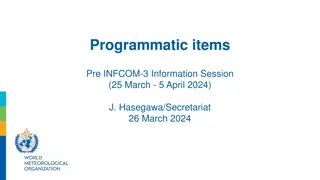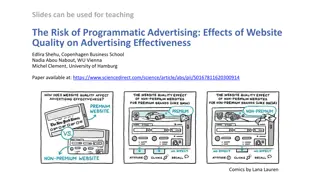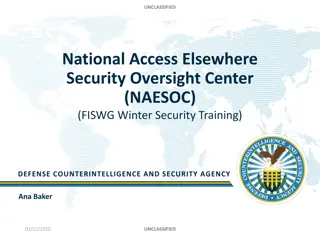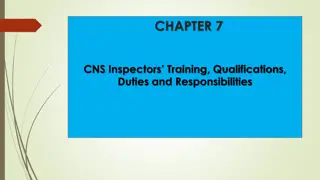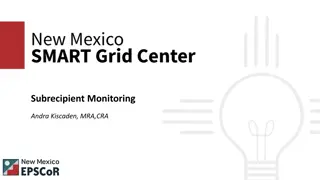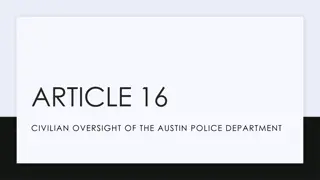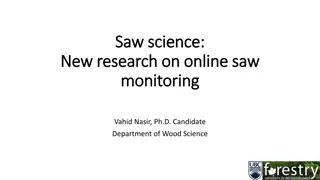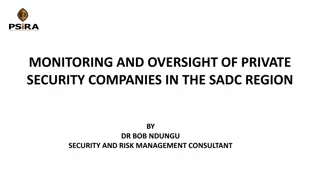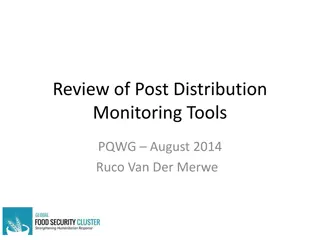Developing Monitoring Tools for Programmatic Oversight
This presentation covers key aspects of monitoring tools for program oversight, including types of monitoring documents, notice of monitoring, and elements to consider. It discusses the importance of informing subawardees about monitoring visits and outlines the components of monitoring forms used in the review process. The session also addresses the significance of asking specific questions during monitoring visits and includes a polling question on the notice period for programs due for monitoring.
Download Presentation

Please find below an Image/Link to download the presentation.
The content on the website is provided AS IS for your information and personal use only. It may not be sold, licensed, or shared on other websites without obtaining consent from the author.If you encounter any issues during the download, it is possible that the publisher has removed the file from their server.
You are allowed to download the files provided on this website for personal or commercial use, subject to the condition that they are used lawfully. All files are the property of their respective owners.
The content on the website is provided AS IS for your information and personal use only. It may not be sold, licensed, or shared on other websites without obtaining consent from the author.
E N D
Presentation Transcript
Developing Monitoring Tools Tonia Moultry, NNEDV Ellen Yin-Wycoff, NNEDV Kimberly Feeney, FVPSA
Agenda Welcome & Introductions of presenters Types of Monitoring Documents What information is needed and why are we asking Sample questions to ask subawardees
Types of Monitoring Documents Notice of monitoring Monitoring form Monitoring report
Notice of Monitoring This form informs a subawardee that their funded program has been scheduled for an onsite programmatic monitoring visit, desk review or fiscal audit This form can be sent to the subawardee via mail or email notice
Notice of Monitoring Elements Name of agency that will be conducting the review Time period that review will cover Type of monitoring: onsite, desk review, fiscal If onsite, include name(s) of administrator who will be conducting the review Names, if known, or position title of staff that will need to be present Documents needed for review and method of submission
Polling Question How much notice do you give programs that they are due for monitoring? 2-4 weeks 1-3 months 3-6 months 6-8 months
Monitoring Form This form is used by the administrator to guide the review process for all subawardees in a standardized method Form may vary based upon the type of review being completed Uniformity ensures that all subawardees are being reviewed on the same elements All sections of the form should be completed. If the administrator is not able to complete a section, an explanation should be provided as why section was not completed
Monitoring Visit When completing a site visit similar questions should be asked to the: Board of Director representative Executive Director or Leadership staff Advocate and staff You are looking for consistency in answers to determine if there is a full understanding of the rules governing the use of funds and service implementation
Monitoring Form Elements Name of agency and staff providing the information Confidentiality, implementation of voluntary services, safety planning Accessibility including language access, disability access, and comparable services for men and transgender community Staff and/or volunteer training Check over blank agency forms: intake, case plan
Polling Question Who monitors for ADA compliance in your state? a. Me (state administrator) b. My agency, different department or program c. Another state agency d. Not sure e. Other
Monitoring Report This form is designed to provide details to the subawardee on the findings of the monitoring review including activities that are being conducted in line with the FVPSA legislation and regulations. If there are activities that need to be corrected to bring them in line with the FVPSA rule this report will outline what those issues are and may provide the subawardee with a way to correct the problem and a date of when the correction is to be completed and will be followed up on by administrator
Corrective Statement Example Subawardee requires every survivor who are seeking services to sign release of information for child protective services or TANF during intake. This does not follow the expectation of voluntary services as outlined in the FVPSA rule. Corrective Action: Subawardee will contact State Coalition to receive technical assistance on providing voluntary services, appropriate uses of releases information to protect survivor s confidentiality Subawardee will inform administrator when action has been completed
Monitoring Report The goal is not for perfect services, but for subawardees to make progress each year For corrective action plans you want to identify those areas that programs are not making progress in after repeated attempts or have not implemented and are in violation of Recommendations can be made for areas where programs have continued to make progress and need additional resources or help
Elements to Document Contact with other local DV program and the state coalition to ensure best practices Types of services provided How and when are those services provided Are the services in line with the intent of the funding Role and structure of the Board of Directors Training and technical assistance needs Relationship with Executive Director Orientation and training protocols and procedures
Elements to Document Implementation of trauma informed services on the hotline and in person Policies & procedures related to accessibility, confidentiality, voluntary services, program eligibility Diversity in the organization does the board and staff reflect the demographics of the communities served Subawardee s engagement and service provision to underserved populations Relationship with culturally specific community based programs
Elements to Document Use of the money helps to fulfill the goals of the state plan Adequate checks and balances on the expenditures of the funds Necessary data is being collected and reports being submitted in a timely fashion. This includes databases How well the subawardee utilizes the funds Accounting practices that are used Who has oversight of programs and services
Polling Question What other elements do you have on your monitoring documents that were not discussed?
Thanks to the following State Administrators Brooke Ely-Milen Colorado Cheryl O Neill Oregon Kristie Mitchell Oklahoma Maine Coalition Against Domestic Violence
Disclaimer The written or spoken examples of monitoring tools and/or questions are not endorsed by the Federal Government, HHS Office or FVPSA office as the best practice or as the definitive way monitoring should be completed. The examples that are being shown are only to provide possible other ways to structure your agency s documents or to ask questions when monitoring subawardees.
Monitoring for State Standards Some states have standards for domestic violence programs that are written in the state statute. If you are in a state such as this, your monitoring visit may include or be structured around the ensuring that the subawardee is meeting the minimum standard
Pass Through Funds There are some states that pass FVPSA funds to subgrantees through the coalition States are still ultimately responsible for the funding As part of this agreement, the coalition may do the monitoring of the subgrantees
Pass Through Funding Monitoring You will want to review the forms that the coalition uses when monitoring the subawardees Both for desk reviews and onsite, if the forms are different It is the responsibility of the state to monitor the coalition and their processes It is recommended that you go with the coalition on some of the onsite monitoring visits This will give you a sense of how the coalition is gathering information Will help you develop a better understanding of the programming, challenges
Monitoring the Coalition Coalitions may receive state FVPSA funds to support programming You will want to ensure that the coalition is on your monitoring rotation This visit will focus on the coalition funding and programming The same forms will apply with the coalition: monitoring notice, monitoring form and report
Monitoring the Coalition As part of the FVPSA funding, state administrators and coalitions are to collaborate on monitoring programs, state planning, and funding decisions. You may meet with the coalition on a regular basis to discuss the needs of the state or emerging issues for local programs This visit will not cover these issues
Monitoring for Programming Elements
What information are we monitoring for? To be able to determine the if the information you are receiving from subawardees meets the requirements of the rules and FOA To figure out follow up questions to ask and what responses/key words you are listening for
Trauma Informed Practices How are staff trained on trauma informed practices? How does the agency ensure that trauma informed practices are being implemented? Provide an example of how hotline calls are answered in a trauma informed manner? What changes has the agency made to be more trauma informed?
Polling Question What questions to you do you ask to determine if the subawardee is implementing trauma informed practices? Write your sample questions in the chat box
Screening Practices How do advocates determine if a survivor is offered shelter or community based services? How do advocates discuss services for mental health and /or substance abuse? If shelter is full and unable to accommodate the survivor, how is this handled? What is the procedure for survivor who has used the services previously? Is this different for survivors who had problems in the program and maybe were asked to leave?
Safety Planning How are advocates trained? Is safety planning different over the phone than in person? How do advocates handle safety planning when the survivor is still in contact? Does the agency do safety planning with children? Who does that? What is the method used?
Voluntary Services How are services presented to survivors? How are service plans/case management plans created? What happens if a survivor chooses to not engage in any services or limited services or will not sign a release of information? Are there any services or activities that survivors or their children must participate in?
Polling Question What questions do you ask to determine if the subawardee s services are voluntary? Write your answer in the chat box
Language Access Plan What are the top 5 languages spoken in your service area? What your plan for providing services to survivors who is limited English proficient? On the phone? In person? How are your staff trained to work with survivors who are limited English proficient? How are less common languages addressed? Can you provide a copy of the written language access plan?
Confidentiality How are survivors informed of confidentiality? What is the protocol for release of information? How are records stored? What is the retention and destruction policy? How are subpoenas and arrest warrants handled?
